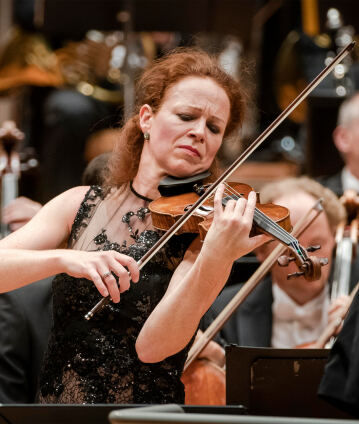François-Xavier Roth and Carolin Widmann

François-Xavier Roth, Generalmusikdirektor of the City of Cologne, presents an evening of fascinating contrasts. He interweaves movements from Debussy’s vividly iridescent Images with the spherical soundscapes of György Ligeti’s famous works Lontano and Atmosphères. In addition there is Bernd Alois Zimmermann’s colourful Violin Concerto with Carolin Widmann as the soloist – the “most headstrong violinist of her generation” (Die Zeit).
François-Xavier Roth owes the fact that he became a conductor to his father, who was titular organist at the Sacré-Cœur de Montmartre church in Paris: “I heard him playing there very often. Everything from Early music, Buxtehude, Pachelbel and Monteverdi, to Olivier Messiaen and our contemporaries. He gave me everything.” As a 9-year-old, Roth began studying the flute, and he became a member of the Orchestre Symphonique de Paris while still a teenager: “It was [...] a dream job for a young flautist. I got to know the whole symphonic repertoire there. It was a special time for me.” The multicoloured orchestral sound wasn’t to let the musician go, and while still an instrumentalist, he was thinking of conducting. His chance came when the conductor of his orchestra wanted to check the sound balance from the auditorium and asked who could conduct for him: “That’s when I knew that this was for me.” Since September 2015, François-Xavier Roth is Gürzenich-Kapellmeister and General Music Director of the City of Cologne.
Together with the Berliner Philharmoniker, he performs Claude Debussy’s iridescent Images pour orchestre a multicoloured, iridescent triptych. Particularly in the three-part Ibéria movement in which polytonal and modal progressions enrich the harmony, an extremely sophisticated sound unfolds: woodwind and brass are almost exclusively employed as the lead melodic instruments, whereby their novel treatment with light-footed splashes of colour, short suggestions and sharply accentuated rhythms ensure that the heaviness of late Romantic symphonies never arises. Something similar can be said about Igor Stravinsky’s Symphonies d’instruments à vent, written in memory of Claude Debussy. This varied programme also includes György Ligeti’s spherical sound space composition Atmosphères, which seems to suspend the laws of gravity with its sombre instrumentation and which moves in dynamics that rarely rise above piano. With Lontano, another classic of the modern era is on the programme: a work by Ligeti, in which the music expands into a form of sound structure which seems at first to approach the listener, only to fade into the furthest distance.
Bernd Alois Zimmermann, the centenary of whose birth is celebrated in 2018, tested the diverse possibilities of a large-scale orchestra in a completely different light in his Violin Concerto, written in 1949/50. The effective second theme in the first movement for example, suggests Shostakovich’s scherzo grotesques. But the Violin Concerto is also the work in Zimmermann’s oeuvre in which the composer approaches the twelve-tone technique for the first time. The equally virtuoso and expressive solo part will be performed by Carolin Widmann on these three evenings.
© 2018 Berlin Phil Media GmbH
Related interviews